
by Sam Lemonick Wednesday, January 2, 2013
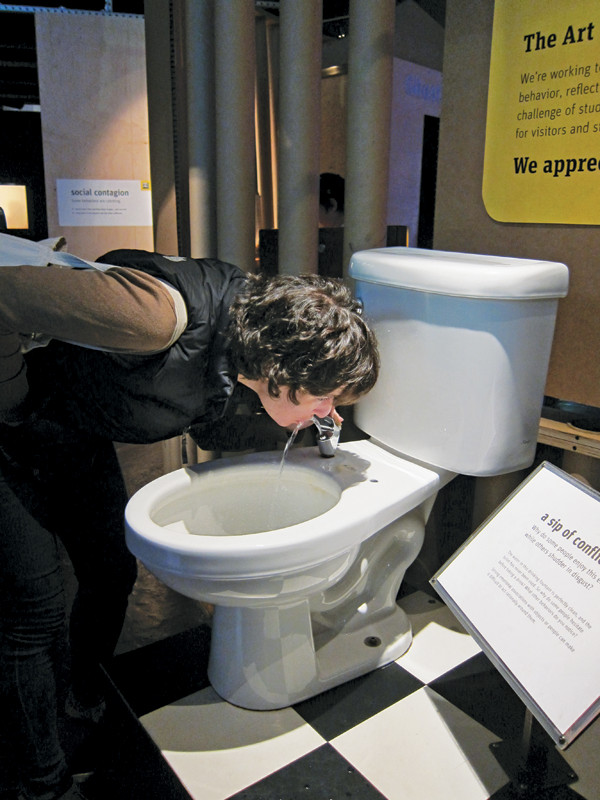
Would you drink water out of a toilet, even if the toilet was never used? That's the question asked at this display at the Exploratorium in San Francisco, Calif. It's also a question on the minds of those working on wastewater recycling plans. Kathleen Canter, with permission of the Exploratorium
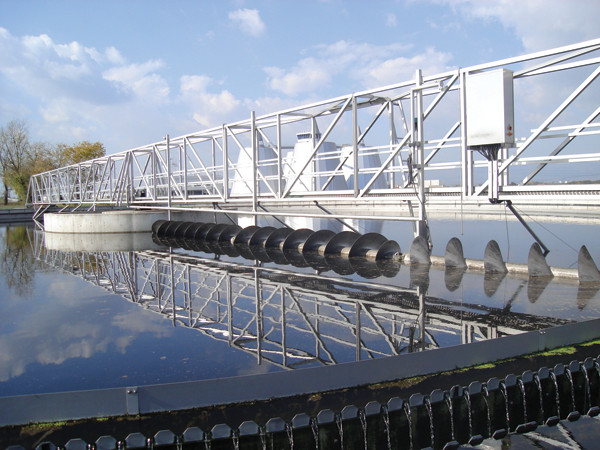
A wastewater settling tank removes sediments and oils as part of a wastewater recycling system. Hasan Zulic, Creative Commons Attribution 3.0 Unported
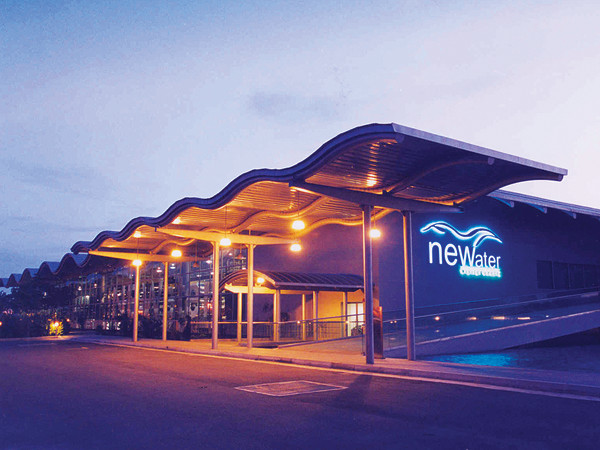
The NEWater Visitor Centre in Singapore. courtesy of the NEWater Visitor Centre, Creative Commons Attribution-NonCommercial-NoDerivs 2.0 Generic
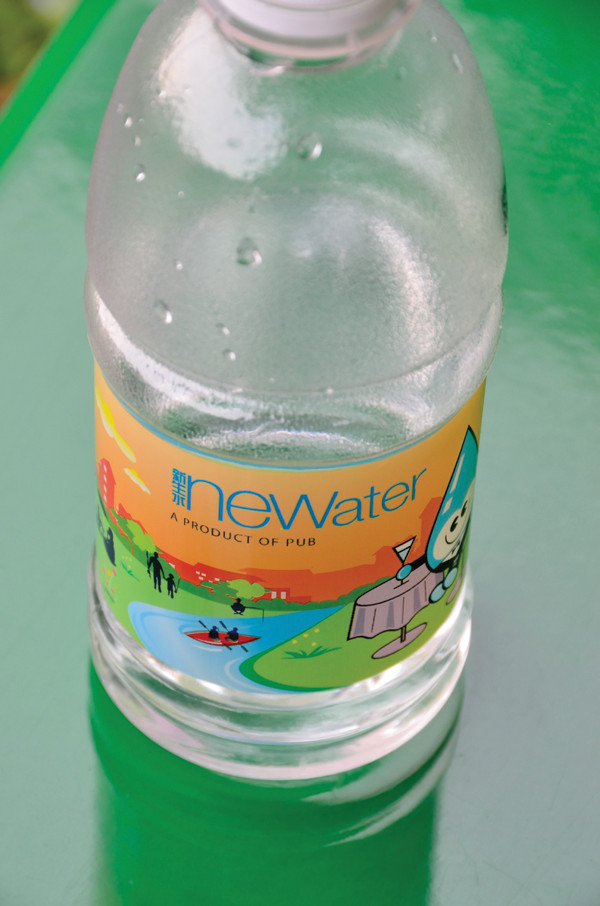
Bottles of "NEWater" or recycled wastewater are offered to visitors to the NEWater Visitor Centre in Singapore. The country has been promoting recycled water as a means to lessen the impact of its limited freshwater supply. Tristan Schmurr, Creative Commons Attribution 2.0 Generic
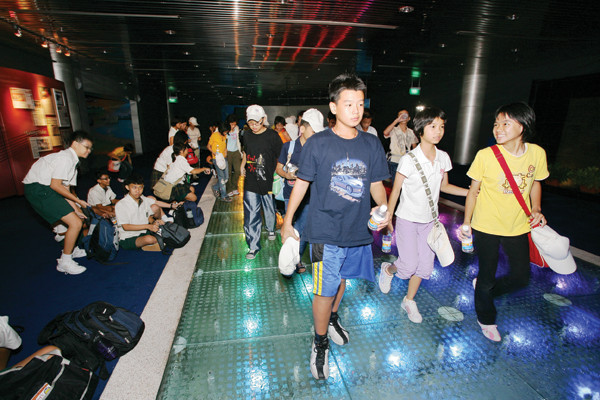
Recycled water flows beneath visitors' feet. courtesy of the NEWater Visitor Centre, Creative Commons Attribution-NonCommercial-NoDerivs 2.0 Generic
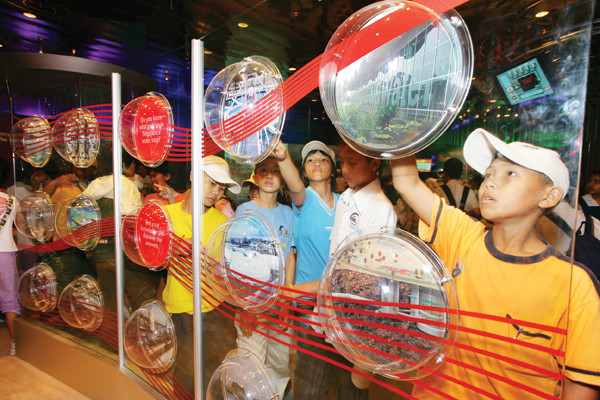
Visitors learn how water is recycled at the NEWater Visitor Centre. courtesy of the NEWater Visitor Centre, Creative Commons Attribution-NonCommercial-NoDerivs 2.0 Generic
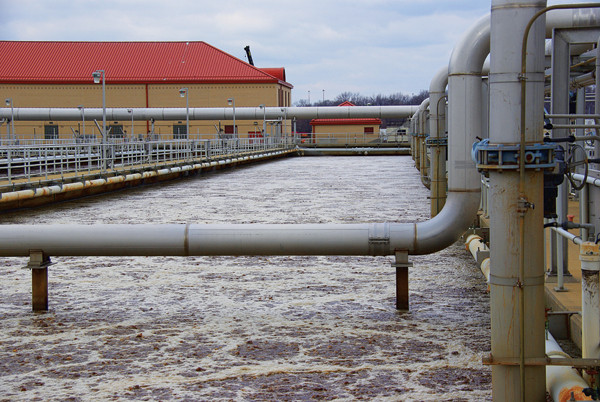
An aeration pool uses microbes to digest organic materials in wastewater as part of wastewater treatment. Kristian Bjornard, Creative Commons Attribution-Share Alike 2.0 Generic
Would you drink water that came from a toilet? The imagery isn’t appealing. Even knowing that the water, once treated, may be cleaner than what comes out of most faucets, many people are disgusted by the idea. But in places like Singapore and Namibia, limited supplies of freshwater are being augmented by adding highly treated wastewater to their drinking water. As climate change and population growth strain freshwater resources, such strategies are likely to become more common around the world, and in the United States.
Freshwater is a more precious commodity than many people in the developed world recognize. More than 97 percent of Earth’s water is saline, unfit for drinking. Of the remainder, more than two-thirds is frozen in glaciers and icecaps, leaving just 1 percent of all the water on our planet fresh. About one one-hundredth of that 1 percent resides in lakes, rivers and other waterways; the rest is in aquifers beneath the surface or trapped in soil. It’s a wonder that so many of us take limitless, on-demand clean water for granted.
Pressure on this invaluable resource is growing. Over the last several decades, regional and local water shortages are becoming increasingly common. Australia saw the worst droughts in its settled history between 1995 and 2009. Droughts across the U.S. last summer crippled farm crops. And people are adding to that burden: Los Angeles, Las Vegas and Phoenix are located in some of the driest parts of the U.S.; they are also among the metro regions experiencing the highest rates of population growth.
Control of water resources is also a point of friction along already-contentious borders between Israel and Jordan, India and Pakistan, and Turkey and Syria, for example. And some experts think that water may supplant oil as a major spark of future conflicts.
“Water is becoming a geopolitical conflict,” says David Feldman, a political scientist at the University of California at Irvine. “When we talk about reclaimed wastewater, we’re not talking about something that’s simply at the level of convenience. We’re really dealing with an issue that is going to be affecting every country, every society.” Avoiding future clashes over water, he says, will mean having to drink treated wastewater.
With only a finite amount of water on the planet, chances are good that the water you drink passed through a person or animal at some point. More directly, many cities use rivers like the Colorado, Mississippi and Thames as their source for drinking water, while at the same time other cities upriver are discharging treated waste into them.
Understanding the process of water treatment can help to make wastewater recycling more palatable, say scientists and activists working to promote its adoption. In most Western cities, when a person flushes a toilet, waste is carried by sewers to a municipal wastewater plant. There, large solid material is separated from liquid with grates or screens. In a settling tank, smaller solids fall out of solution while oils rise to the surface and are skimmed off. The wastewater next moves to an aeration tank, where microbes feed on the waste and break it down. After a final settling step, the clarified water is treated with ultraviolet light, chemicals like chlorine, or other processes to kill any remaining germs before the water is released back into the environment. Many of these steps are then repeated when water for consumption is drawn from the same river, lake or reservoir where the treated wastewater was released.
In essence, advocates of recycling wastewater for human consumption merely want to shorten this pathway, by reintroducing highly treated wastewater into water supplies without first depositing it in an intervening lake or river. Several cities around the world are already showing that it’s possible.
Singapore might be the most well-known wastewater recycler. The island nation off the southern tip of Malaysia is a little more than half the size of Los Angeles geographically but has about 1.3 million more residents. Although Singapore’s annual rainfall is more than double the global average, collecting and storing enough water is difficult because open land is scarce. Even with reservoirs covering half the country’s land area, Singapore only has enough water for 60 percent of its daily needs.
Singapore has traditionally imported the remaining 40 percent from neighboring Malaysia. Two treaties signed in the 1960s have ensured that the country has enough clean water for drinking, agriculture and industrial processes. Because Singapore’s economy relies heavily on exports, ensuring that there is high-quality water to make electronics and other goods is essential. Singapore’s agreements with Malaysia are slated to last until 2061.
Despite a historically cordial relationship, Malaysian politicians have occasionally threatened to use water as leverage against Singapore. In 1998 and 2002, Malaysia proposed raising the price on the water the country sold to Singapore. Talks broke down, and although those negotiations later resumed, Singapore decided to pursue a new strategy: water independence. The government supported a so-called “Four Taps” plan, which would make use of Singapore’s reservoirs, water imported from Malaysia, recycled wastewater and desalinated seawater.
The idea of recycling wastewater in Singapore actually began decades earlier. In 1974, an experimental plant was built, but cost and reliability problems shut it down a year later. In 1998, Singapore’s Public Utilities Board (PUB), which handles the country’s water, opened a new investigation into the feasibility of making clean water from sewage. Since then, PUB has built four of its so-called NEWater plants.
Cleaning wastewater begins with conventional treatment. Microfiltration is next, in which the water flows through a series of tubes containing filters with microscopic pores, each 500 times smaller than the thickness of a human hair. While water flows into the tubes and on to the next step, microbes and all but the smallest solids are filtered out and don’t pass through the tubes.
The next step is a process called reverse osmosis, a technology used in a wide range of water purification technologies to produce everything from drinking water to cleaner car washes. Reverse osmosis uses high pressure to force water through a plastic membrane with pores so small that even dissolved salts typically cannot get through. Although reverse osmosis is usually enough to reliably remove all contaminants, the water flows past ultraviolet lamps to ensure that it is completely sterilized in the last step of the NEWater production process.
Guests at the NEWater Visitor Centre in southeastern Singapore can sample the treated water, which is entirely safe to drink. PUB reports that its water exceeds drinking water standards set by the U.S. Environmental Protection Agency and the World Health Organization, and is in fact cleaner than the water that flows to taps in Singapore. It is so clean that most NEWater is used in industrial processes that require extremely pure water. PUB sends about 6 percent of the NEWater it makes to reservoirs that supply drinking water, although the agency has plans to increase this share of indirect potable water. By growing NEWater production, increasing desalination and imposing regulations to encourage water conservation, Singapore hopes to become water independent by the time its final treaty with Malaysia expires in 2061.
Similar efforts to stretch limited water resources are also in progress in the U.S., although to a lesser extent. Some municipalities are adapting existing wastewater treatment plants and processes for the task. San Diego County recently opened a pilot wastewater recycling plant that uses a method similar to Singapore’s. The county’s example is indicative of the difficulties of introducing recycled wastewater into the water supply and may serve as a model for future attempts.
The San Diego County Water Authority first proposed the water reuse initiative in 1998. The city council balked at the idea and shut the project down. A 2004 survey showed 63 percent of county residents opposed adding treated wastewater to the drinking water supply. Like other counties in Southern California, San Diego imports much of its water from inland regions, an expensive proposition made increasingly tenuous by drought and population growth that increase upstream demand. Thus, the water authority has turned to community and environmental groups to help educate the public about the safety of recycled water.
In 2009, after two years of drought, water rationing regulations restricted when people could water their lawns and what kinds of fountains they could have in their gardens. Industry leaders told San Diego Mayor Jerry Sanders that if water shortages continued, they might relocate to other regions. Sanders, who had been opposed to water recycling, reportedly changed his mind at the prospect of losing business. The city now hopes that recycled wastewater will make up 7 percent of its reservoirs by the end of the decade. What’s more, recent polls show that opposition to reused water has fallen to only 25 percent.
Other U.S. locations have seen similar difficulties and progress. Orange County, Calif., uses a process like Singapore’s, generating as much as 265 million liters of clean water from wastewater each day — enough to supply 20,000 average U.S. households. That recycled water is as pure as distilled water and is injected into the aquifers that supply the county’s drinking water. There, it replenishes supplies that have been severely depleted by drought and population growth, and it helps prevent seawater from the Pacific Ocean from intruding and contaminating the freshwater. Fairfax County, Va., just outside of Washington, D.C., likewise produces recycled water that it adds to the county’s reservoirs.
Technologies being developed and refined right now will help make wastewater recycling more efficient and less expensive, but talking people into drinking “flush to faucet” water is the bigger challenge, experts say.
Studies have repeatedly shown that people have a strong aversion to consuming potentially contaminated food or drink. The “yuck factor” applies even when they know the food or water is clean. Two studies are routinely cited to illustrate that point. In one, psychologists sterilized a cockroach and dipped it in a glass of water. Out of 50 people, only one drank from the glass. In a similar study, researchers poured apple juice into a brand-new, never-been-used bedpan. Even though they knew and admitted that it was perfectly clean, most people refused to drink the juice.
Scientists say the aversion to human waste is universal across all cultures. Still, in a 2004 article in the magazine of the American Psychological Society, the researcher behind the cockroach study, Paul Rozin of the University of Pennsylvania, wrote that human psychology might also hold the answer to acceptance of recycled wastewater.
For many, scientific arguments about water purity are trumped by a gut feeling that recycled water’s history makes it dirty. Rozin said in his article, however, that an extra step — like a river that carries treated wastewater from one city to a drinking water treatment plant in another — can erase that hesitation. Other mental tricks help most of us ignore objectively dirty objects like coins and dollar bills, for instance, so we can function in society.
Rozin says putting wastewater into rivers and aquifers, not water pipes, can be more expensive but may be useful for gaining public acceptance. He notes that an endorsement by a trusted group, like the Surfrider Foundation, which helped raise support for wastewater reuse in San Diego, can also reduce stigma. The Singapore government has shown the value of a third tactic: a public information campaign that emphasized the economic and national security benefits of making the country’s water supply more independent.
The case for recycled wastewater is strong. A 2012 National Academy of Sciences study found that U.S. coastal cities could increase their water supply 27 percent with treated wastewater. Singapore offers one good example. Israel is a second: It recycles 80 percent of its sewage, using much of it for irrigation. Namibia’s pioneering capital, Windhoek, which faces regular droughts, began sending recycled water from sewage directly into its water system in 1968 and continues to do so today. In Australia, which faced severe droughts for most of the 2000s, many cities are embracing water reuse. If people can be convinced to drink it, use of recycled water may grow rapidly. Several new technologies being developed today may help make that possible.
According to the Institute of Environmental Science and Engineering, based in Singapore, something known as an anaerobic membrane bioreactor could lower the cost of wastewater treatment and its environmental impact. Traditional membrane bioreactors are already used in many modern wastewater treatment plants. They shorten the conventional sewage treatment process by adding a membrane to the aeration step, where aerobic bacteria, those that consume oxygen to respire, break down the organic matter in sewage. By sending the water through a membrane, follow-up settling and filtration steps are not necessary. After passing through a membrane bioreactor, water is clean enough to be discharged or can be used for irrigation.
An anaerobic membrane bioreactor, by contrast, uses bacteria that don’t need oxygen to breathe, so oxygen is not bubbled through the reactors, thereby reducing treatment costs. And they can consume more solid waste, reducing the amount requiring costly disposal. In the right configuration, they also release less methane than conventional membrane bioreactors.
Researchers at the J. Craig Venter Institute in San Diego, including Orianna Bretschger, are working on another use of microbes for wastewater treatment: microbial fuel cells, in which bacteria breaking down sewage also generate electricity.
A microbial fuel cell consists of two chambers of water separated by a membrane. A wire connects two electrodes, one in each chamber. On one side, anaerobic bacteria feed on sewage. As they break the organic matter down, they produce electrons and positively charged hydrogen atoms called protons. The electrons flow to the electrode and across the wire, generating an electrical current. At the same time, the protons pass through the membrane and into the other chamber, where they combine with the electrons flowing into that electrode and with oxygen in the solution to make pure water.
Bretschger reports that her latest prototypes can remove 99.9 percent of organic substances from wastewater while producing electricity — albeit only a small amount so far. She says a microbial fuel cell like hers could replace a number of steps in wastewater treatment: “We can remove almost all the organics that are solubilized in the effluent, but even if you do that, just because you are still working with a biological system, you are still going to need a filtration step.” Her group focuses on finding the best bacteria for the job, while other groups around the world are looking to maximize performance in other ways, like using new materials. When optimized, the devices could help power wastewater treatment plants while they clean sewage.
Other scientists have made a device that uses light and electricity to clean water. Ultraviolet light activates titanium oxide on one side of an electrode. The resulting reaction breaks down pollutants. On the other side, electricity activates a similar reaction. Its inventor, Aicheng Chen, a chemist at Lakehead University in Thunder Bay, Ontario, reported in 2009 in Environmental Science & Technology that the device was particularly effective against pharmaceuticals, pesticides, dyes and other molecules. Those compounds are the most difficult to remove when treating wastewater, Bretschger says, adding that conventional wastewater treatment cannot prevent possibly dangerous levels of these chemicals from building up in the environment.
While these advances hold promise, they aren’t the only avenue water recycling advocates are pursuing. Regulations, in addition to a skeptical public, still stand in the way of wastewater recycling in many places, Feldman says. He says getting the regulatory system for drinking water and other uses of water in sync with science is the first step.
Nonetheless, he says, it is only a matter of time before wastewater reuse becomes more commonplace. “I think between climate change, increased urbanization and growing demands for food and energy, there’s really no way around reusing wastewater.”
© 2008-2021. All rights reserved. Any copying, redistribution or retransmission of any of the contents of this service without the expressed written permission of the American Geosciences Institute is expressly prohibited. Click here for all copyright requests.